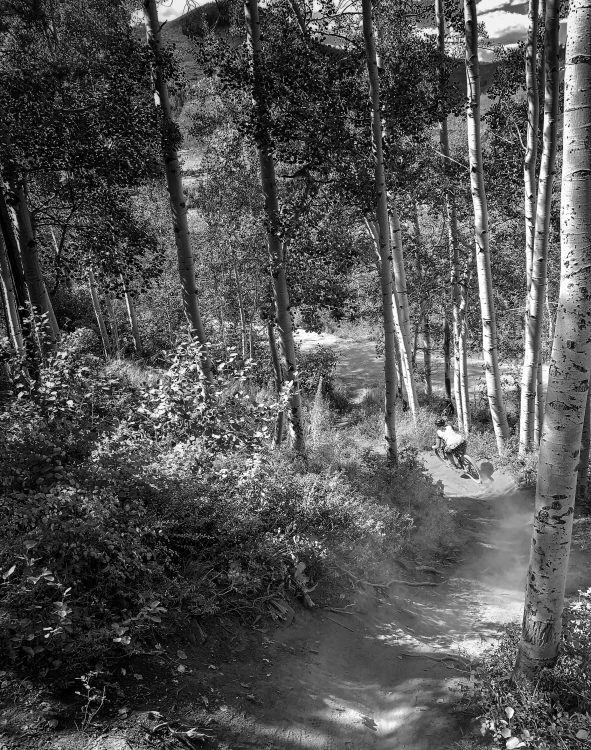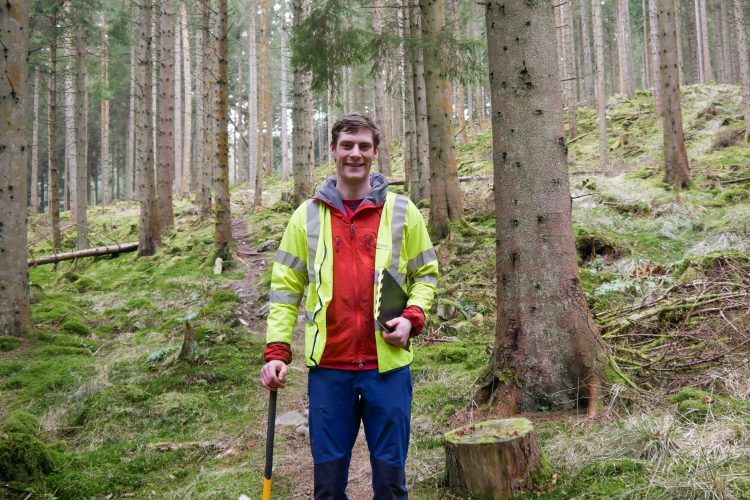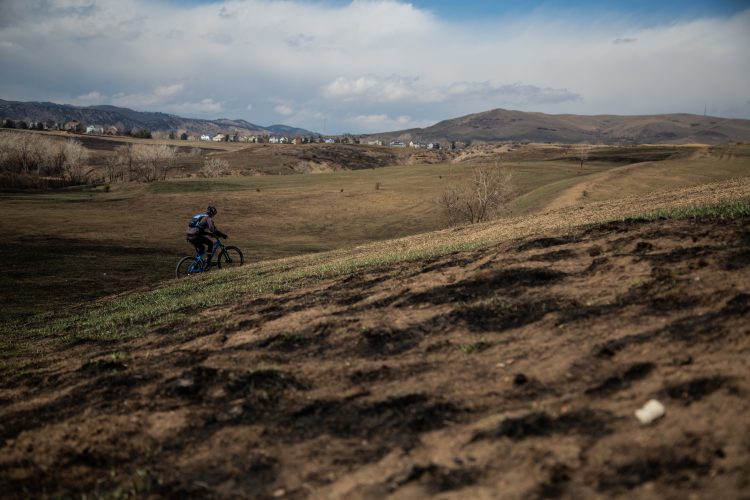
There has been a flurry of media coverage and concern about the state of wildlife in Vail, and how it’s been impacted by recreation in the tourist-rich area. The underlying theme and perception is that dramatic increases in population, visitation, residential and trail development, and subsequent recreation has dramatically lowered the elk population.
All of these elements factor into why Colorado Parks and Wildlife (CPW) can’t seem to bring the elk population back into the middle rung of its objective range, but Ernest Saeger, the executive director of the Vail Valley Mountain Trails Alliance (VVMTA) doesn’t appreciate that recreationists have taken the brunt of the blame.
“There are so many factors that play into this conversation beyond the impacts that development, recreation, and population growth including increased predator populations and even climate change,” says Saeger.
When people read damning headlines and the association between recreation and a decline in wildlife, he says, “The public takes this as finger pointing and truly believes that there are 53 elk left in our area when in reality the populations are currently within their management numbers.”
In the summer of 2018, reports were published across Colorado newspapers and beyond that elk populations were halved over a span of about fifteen years, and the calf to cow ratio had dropped from about 50 calves per 100 cows to around 35 per 100.
According to CPW, the agency and other land managers have been talking about a decline for nearly a decade, but when when the three-year average calf-to-cow ratios dropped to the 30s, and the population declined toward the bottom range of CPW’s goal, the conversation started to escalate.
What Saeger sees lost in the conversation though, is that CPW purposely reduced the elk population because of wildlife and human conflict; something as simple as too many elk crossing the highway or elk getting into a rancher’s stack yards. The reduction of about 13,000 elk to the currently estimated 6,000 was part of the agency’s plan to diminish conflict.
“That was, back then, something that the Division of Wildlife was trying to manage,” says Area Wildlife Manager Matt Yamashita of CPW. “We were trying to decrease numbers and our primary tool for decreasing those numbers was through issuance of hunting licenses, and back then it kind of didn’t matter how many hunting licenses we put out there or what our harvest was. We could increase our harvest and it didn’t result in any net decrease in population.”
The most recent population estimate from 2019 says that in DAUs (data analysis unit) 12 and 16, both around Vail and Eagle, there are respectively 3,910 and 6,180 with bull-to-cow ratios of 28 and 20 to 100, respectively. The bull-to-cow ratios are much lower than they were 20 years ago, but the 1998 herd management plan set the desired ratio in E-16 to 20:100, with the actual average resting at 25:100.
From 1998 to 2013, the elk in E16 were managed for an objective of 5,100 animals, and through the 1990s and early 2000s, CPW documents state that the numbers doubled to over 10,000 elk. Giving out “liberal antlerless licenses” to increase cow elk harvest reduced the population to around 7,100 in 2013 for E16. Elk in E12 were managed in a similar manner.

The 2013 plan, “long overdue for an update” at the time it was written, attributes land development to the direct loss of habitat quantity and quality, while year-round outdoor recreation has had the largest indirect impact to elk herds.
“Since then, you fast forward two decades and a lot of things have changed outside of the realm of agriculture and hunting and everything else, you know,” says Yamashita. “Insert significant development, significant human disturbance in areas, an increase in recreation, an increase in predator numbers and there’s a lot of different variables that are now contributing toward this decrease, not a single one of them is the silver bullet or the smoking gun that’s causing this effect.”
In 2013, CPW had three alternatives for a new population objective range for E16: 7,000-10,000 elk, 5,500-8,500 elk, and 4,000-7,000 elk. They chose the middle objective with wiggle room of about 20%, because it would maintain the current size and reduce in-herd competition for foraging and habitat. A higher population would allow disease to spread more easily and increase competition for foraging, likely resulting in a population decline anyway. The lower goal would encourage health and decrease foraging competition, but could make the herds more susceptible to predation.
The selected range for E12, with similar consequences to E16 for any choice, was 3,000-4,600 elk. So, both E12 and E16 are still within their desired ranges, but on the lower end of the scale.
CPW’s response and recommendation to the land agencies around Vail, the U.S. Forest Service and Bureau of Land Management, has been a reduction in hunting licenses. In several cases, Yamashita says, female harvests were completely eliminated. But, the elk seem as stubborn to rebound thus far, as they were to reduce when hunting permits were copious.
“So we’ve essentially nullified the effects of the hunting pressure on a lot of those developed populations over here. That hasn’t necessarily shown a remarkable change in the elk rebounding and populations returning.” Hunting licenses are one of the variables that CPW has direct control over, but it might take a few years before changes are noticeable.

Controlling some of those indirect effects on elk population is where the VVMTA comes in with their wildlife trail ambassador program. Typically, mountain bike organizations will recruit volunteers to help build and maintain trails. This program puts volunteers at trailheads to help visitors understand trail closures, visitors who would otherwise creep past the gate for a ride or hike. From April 2020 to April 2021, VVMTA wildlife ambassadors volunteered 236 hours, contacted 260 people, and recorded 203 people and 94 dogs on closed trails.
While it seems like it would be mostly brazen mountain bike tourists disobeying the orders, Saeger of the VVMTA says it’s people from all user groups, plenty of whom are local.
Calf-to-elk recruitment — the successful joining of a calf after one year into a herd — does seem to be affected and in decline in the area, which is said to be contributing to the stagnant population. CPW officials are now studying the issue. In CPW’s 2013 herd management plan, they noted that outdoor recreation, including hiking, dog-walking, XC skiing, OHV use, antler shed hunting, and mountain biking have “increased tremendously in the past 15-20 years.”
Even though the animals might seem unperturbed by someone’s presence, studies show that recreation can displace elk and ultimately shake the survival and recruitment rate of calves.
“These behavioral stressors and additional mortality can reduce recruitment of calves into the population directly by limiting calf survival, as well as indirectly by pushing elk off of preferred feeding and bedding areas,” the 2013 plan states.
The wildlife ambassador program didn’t start as a result of the information that came about in 2018/9. It was sort of the opposite. The VVMTA pitched a trail to the White River National Forest Service district as a year-old organization in 2012, and were told that the agency was already behind on maintenance on the current trails. Creating more trails in the district put the horse in front of the carriage. Five years later with dirt on their hands, VVMTA proposed the Everkrisp trail again, which would connect the towns of Minturn and EagleVail and enhance continuity with other trails.
VVMTA had more credibility this time around, so the district was open to the idea, but since the proposed trail ran through a winter elk habitat, the trail and analysis called for a seasonal closure from late November to late June.
“That trail spurred all of the conversation that you’ve been reading and all of the programs and committees and coalitions that have been created and are formed and functioning on a monthly basis here now,” says Saeger.
“Everkrisp will have a negligible, if not zero, effect on wildlife and elk herd on that hillside — if we can maintain and enforce the wildlife closure on that trail. That’s the big piece.” Aaron Mayville, the district ranger of the Eagle-Holy Cross USFS district at the time told the Vail Daily in the summer of 2019. “When I approved this trail, I was gambling a little bit and put my faith in the community that they’re going to adhere to those closures. So far, so good. We’re going to really see that once that trail gets open.”
VVMTA hosts a few trainings per year where volunteers learn how to record their data, how to talk to trailhead visitors, and are taught to avoid any potential conflict. The goal is education, and if there are visitors who disregard the closure, ambassadors can call a ranger. VVMTA tries to put ambassadors out during peak hours — mornings, lunchtime, and weekends — for an hour or two at a time.
Though mountain bikers have gained a rap for demanding more trails, Saeger says that’s not the case for the organization currently. In the past decade, the only new trail that has been added to the WRNF-Eagle-Holy Cross District is the Everkrisp trail. VVMTA is focused on increasing the density of already-developed networks, rather than carving new trails into the backcountry and potentially fragmenting more habitat.
Researcher Paul Millhouser sees that as a good option. Millhouser, who now works at Colorado State University, conducted a study when he previously worked at Rocky Mountain Wild, where he evaluated the elk population in the Vail area over the past few decades, and plotted them against road, infrastructure, and housing development to find out exactly how elk habitat had been fragmented.
Millhouser knew the populations were down, and there could be several factors including harsh winters, predation, disease and so on, but even totaling the variables and considering hunting, the decline seemed sharp to him.
“You can’t rule those things out, all you can say is there seems to be more change than those things could account for on their own. Those things didn’t seem to change so radically during that period of time that they on their own would be driving that larger change in the population.”
Millhouser says that during the period of the decline, there was more development, more hunting, and an increase in recreation, all which could have had an impact. Hunting is easy to calculate via CPW’s records of available tags and harvests, and tracking road development comes easily as well, but recreation is where it gets sticky, since land managers generally don’t keep count of who’s skiing, hiking, or biking.
Therein lies the problem with calving as the population problem is two-fold; more elk killed obviously meant a lower population, but if there are more humans present during calving season, then there will be an impact on calf recruitment. Seasonal closures should help, but Millhouser argues that even summer activity can be detrimental to herd health, if elk are trying to fatten up for the winter and have less habitat to forage.
Millhouser believes that the smaller population will ultimately be unsustainable. CPW isn’t sure. The ironic component to all of this is that CPW’s management goals are also motivated by the local human populace’s desires to have a reasonable amount of elk in the area for viewing and hunting.
“CPW has the capacity to manage wildlife populations at various levels based on public and community want and habitat capacity. However, there is a point of diminishing returns when numbers are so low that recovery becomes impossible,” says Yamashita of CPW. “The mountain counties and communities of the Vail, Eagle and Roaring Fork valleys have all made it clear to CPW that the wildlife resource is an important component of these areas and they want these species to perpetuate into the future in more significant numbers than where we are headed.”
Human populations are of course expected to increase in and around Vail. Likely, there will be more humans moving there and visiting for the combination of nature, recreation, and the rugged luxuries that mountain communities in Vail provide.
In January of 2020, CPW, local USFS districts, the Town of Vail, VVMTA, and other local organizations and stakeholders started the Eagle County Community Wildlife Roundtable. The group meets and discusses wildlife in the county, and how they can support and protect the animals.
“And it’s been very good,” says Saeger. “It’s been very collaborative and it’s really making some good strides for our community, coming together to figure out how we can battle this.” They have a habitat committee, recreation, land use, and education and outreach committees. Rather than pointing fingers across user groups, or from recreation to development, they’re all conversing with one another to try and solve the issue as a single group.
“It’s really people in general. There’s just more people.” And planning for even more people — and the coexistence among wildlife — will remain a priority for VVMTA.
“I would argue that if we don’t smartly plan for sustainable trail building and trail use to mitigate impacts on wildlife, then it will be a ‘biological desert.’ Because doing nothing to plan for the current increase in recreation and only increasing numbers is the absolute worst thing we can do.”





















